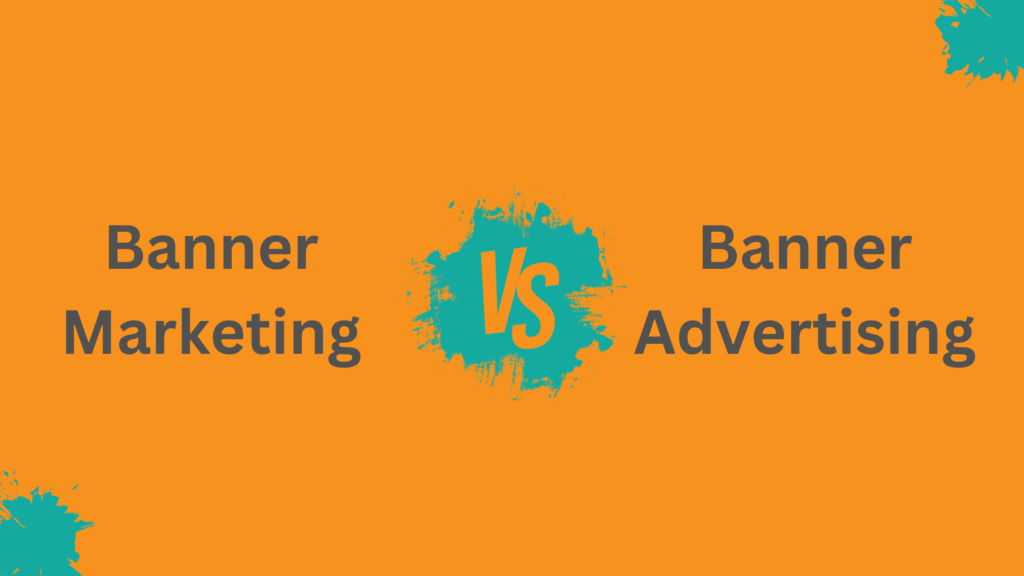
In today’s fast-paced digital world, marketers always search for new ways to grab people’s attention. Amidst all the new strategies, one old method has remained strong and adapted to the changes – Banner Marketing.
Think of it like this: while many trends come and go quickly, But, this has stuck around and become even more powerful. It’s a method that has proven its value in online advertising.
In this blog, we will cover a range of topics, including an explanation of Banner Marketing, a comparison of Banner Marketing and Banner Advertising, critical distinctions between the two, the advantages of Banner Marketing, various types of Banner Marketing, strategies for effective Banner Marketing, common errors to steer clear of, and finally, our concluding thoughts.
So, whether you’re a seasoned marketer looking to refine your banner ad campaigns or a business owner curious about the potential of Banner Marketing, fasten your seatbelts as we embark on a journey to uncover the strategies and secrets behind this enduring advertising medium.
So, let’s get started;
What Is Banner Marketing?
It is a comprehensive digital marketing strategy that strategically employs visual banners or graphical elements across various online platforms, such as websites, social media, and email, to enhance brand visibility, engage target audiences, and promote products or services.
You might be wondering about the distinction between banner marketing and banner advertising. Well, don’t worry; let’s clarify that.
Banner Marketing Vs. Banner Advertising

Banner Advertising
Banner Advertising is a specific type of online advertising with graphical banner ads displayed on websites and other digital platforms. These ads are typically designed to capture users’ attention and promote products, services, or brands.

The primary goal of Banner Advertising is to drive traffic, raise brand awareness, and encourage user interaction or conversions by using clickable elements that lead to the advertiser’s website or landing page.
Banner Marketing
Banner Marketing, on the other hand, is a broader and more strategic approach. It encompasses using visual banners or graphical elements across various digital channels, including websites, social media, email, and more, to enhance brand visibility, engage target audiences, and promote products or services.
Unlike Banner Advertising, it focuses on creating a cohesive and visually appealing brand presence across multiple touchpoints rather than aiming for immediate clicks and conversions.
Critical Differences Between Banner Marketing And Banner Advertising
Scope and Purpose
- Banner Advertising is primarily focused on immediate click-through rates and conversions.
- It has a broader scope, aiming to establish a consistent brand presence and engage audiences across various online platforms.
Placement and Strategy
- Banner Advertising typically involves paid placements on specific websites or within ad networks.
- It strategically uses banners as a part of an integrated marketing strategy that includes multiple channels and touchpoints.
Engagement Goals
- Banner Advertising’s primary goal is encouraging users to click on the banner and take immediate action.
- It seeks to engage users visually, leaving a lasting impression even if immediate interaction doesn’t occur.
Long-Term Brand Building
- Banner Advertising is more transactional, with a focus on short-term results.
- It emphasizes long-term brand building and creating a memorable brand image.
Content and Design
- Banner Advertising often features direct and explicit call-to-action elements.
- It focuses on creating visually appealing and brand-consistent banners that may only sometimes include explicit calls to action.
Now that we have a solid grasp of both banner marketing and banner advertising, let’s shift our focus to the main subject of this blog: banner marketing.
Benefits Of Banner Marketing

- Increased Brand Visibility: It helps enhance your brand’s visibility across digital platforms, making it more recognizable to your target audience. Consistent banner designs and messaging create a memorable brand image.
- Targeted Audience Engagement: It allows you to tailor your banners to your target audience’s demographics, interests, and behaviors. This targeted approach increases the likelihood of engaging potential customers more likely to convert.
- Enhanced User Experience: Well-designed banners can improve the overall user experience on websites and social media platforms by providing relevant information, promoting products or services, and guiding users to desired actions without intruding.
- Measurable Performance Metrics: It provides valuable data and performance metrics. You can track click-through rates (CTR), impressions, conversions, and metrics. These insights help you refine your marketing strategy for better results.
Now, let’s explore the strategies that make banner marketing effective.
Effective Banner Marketing Strategies

Designing Compelling Banner Ads

- Visual Appeal: Create visually appealing banners that align with your brand’s identity and messaging. Use high-quality images, straightforward typography, and compelling graphics.
- Clear Message: Communicate your message concisely. Use persuasive language and a solid call to action (CTA) that tells the viewer what to do next.
- Responsive Design: Ensure your banners are responsive and display well on various devices and screen sizes, including mobile phones and tablets.
Choosing The Right Placement

- Target Audience: Identify where your target audience spends their time online. Place your banners on websites, social media platforms, or email newsletters that cater to your audience’s interests.
- Contextual Relevance: Ensure that your banners are contextually relevant to the content on the page where they are displayed. This increases the likelihood of engagement.
Utilizing A/B Testing
- Conduct A/B tests with different banner variations to determine which designs, messages, or CTAs resonate best with your audience.
- Test elements like color schemes, images, ad copy, and CTA buttons to optimize banner performance.
- Continuously refine your banners based on the insights gathered from A/B testing.
Tracking And Analyzing Performance

- Use tracking tools and analytics platforms to monitor the performance of your banner marketing campaigns.
- Key performance indicators (KPIs) include click-through rates (CTR), conversion rates, impressions, and bounce rates.
- Analyze user behavior data to understand how users interact with your banners and make data-driven improvements.
By incorporating these strategies into your banner marketing campaigns, you can create compelling banners that capture your audience’s attention and drive engagement and conversions.
Next, we’ll discuss the errors you should avoid in banner marketing.
Common Mistakes To Avoid In Banner Marketing
Banner Blindness
- Explanation: Banner blindness occurs when users automatically ignore or overlook banner ads due to their frequent exposure to them.
- Solution: Combat banner blindness by creating visually appealing and engaging banners that stand out without overly intrusive. Consider innovative design techniques and placements to capture user attention.
Irrelevant Content
- Explanation: Displaying banners irrelevant to the content or the interests of the website or platform’s audience can result in poor engagement.
- Solution: Ensure that your banners align with the context and interests of the platform or webpage where they are displayed. Tailor your messaging to the specific audience to increase relevance.
Overloading with Information
- Explanation: Conveying too much information within a single banner can overwhelm users and lead to confusion or disinterest.
- Solution: Keep banner content concise and focused. Highlight one clear message or offer, and use compelling visuals to convey it. Consider directing users to a landing page for additional details if more information is needed.
Ignoring Analytics
- Explanation: Remember to track and analyze the performance of your banner marketing campaigns means missing out on valuable insights for optimization.
- Solution: Implement tracking tools and analytics to monitor key performance indicators (KPIs) such as click-through rates (CTR), conversions, and bounce rates. Regularly review and analyze this data to make data-driven improvements to your campaigns.
Conclusion
At this point, you should have a solid understanding of banner marketing, and it’s important to distinguish it from banner advertising. Take advantage of these banner marketing strategies today.
If you still have any questions related to the topic, then feel free to leave your questions in the comments section. We will be happy to answer you
Thanks for reading 🙂








No Comments